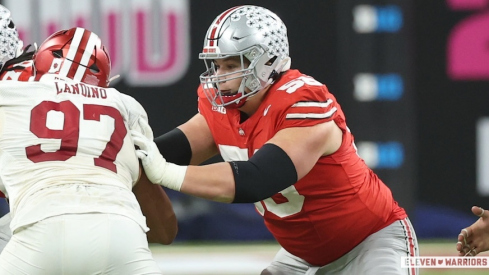In 1895, representatives from seven Midwestern universities gathered in Chicago's Palmer House Hotel to discuss the regulation of intercollegiate athletics. Shortly after, the group created the first Division I collegiate athletic conference in the United States.
Over 120 years later, that conference still stands. The Big Ten currently features 14 member schools from as far west as Lincoln, Nebraska, and as far east as New Brunswick, New Jersey, competing against each other in 28 different sports.
The conference has grown so large and competitive across all sports that we felt there should be an award for the best performing Big Ten athletic program each season. So for the second year, we give you the Palmer House Cup, awarded to the top athletic program in the conference.
Much like the NACDA Directors Cup, the Palmer House Cup tracks each Big Ten school's performance in every Big Ten-sponsored sport with the aim of crowning the conference's top-performing athletic program across all sports.
Final Results
| Place | Team | Points | Bonus Points | Total Score |
|---|---|---|---|---|
| 1 | Ohio State | 976.92 | 250 | 1,226.92 |
| 2 | Michigan | 951.52 | 250 | 1,201.52 |
| 3 | Penn State | 824.33 | 175 | 999.33 |
| 4 | Minnesota | 878.50 | 100 | 978.50 |
| 5 | Nebraska | 787.92 | 100 | 887.92 |
| 6 | Indiana | 844.09 | 25 | 869.09 |
| 7 | Illinois | 817.04 | 25 | 842.04 |
| 8 | Maryland | 720.94 | 100 | 820.94 |
| 9 | Michigan State | 778.41 | 0 | 778.41 |
| 10 | Northwestern | 774.68 | 0 | 774.68 |
| 11 | Wisconsin | 699.87 | 25 | 724.87 |
| 12 | Iowa | 693.89 | 25 | 718.89 |
| 13 | Purdue | 672.43 | 0 | 672.43 |
| 14 | Rutgers | 299.71 | 0 | 299.71 |
For the second-straight year, Ohio State had the top athletic program in the Big Ten. The Buckeyes won at least a share of seven regular season Big Ten championships, four conference tournaments or championship games, and finished in the top-four nationally in fencing and men's hockey and had runner-up finishes in wrestling and men's tennis. The Buckeyes also won a national title in pistol and had top-four finishes in women's ice hockey and men's volleyball, but neither are Big Ten sports and were not counted towards their total.
Michigan came in a very close second with six Big Ten championships of its own, and enough top national finishes to tie Ohio State in bonus points and cement itself into second place. Last year, the Wolverines had the second-most regular points, but were passed by Penn State and Maryland in the total score due to bonus points
Despite substantially increasing its score from last year, Rutgers was still last by a wide, wide margin. The Scarlet Knights finished last in the conference 11 times this year – down from 12 last year. Since Rutgers competes in 23 Big Ten sports, the Scarlet Knights were the worst team in the Big Ten only slightly less than most of the time.
Scoring
For each sport, every team is given a score based on its final regular season conference standing (when possible) out of how many teams competed in that sport with the first-place team earning 100 points and the last-place team earning 0. For example, a fifth-place finisher in football (out of 14 teams) would get 69.23 points while a fifth-place finisher in hockey (out of six teams) would get 20 points, much like how an exam is scored.
We then take the 10 best scores from each school, add them together, add any bonus points (explained in the next section) and that becomes the team's grand total which is used to calculate the winner of the cup.
This scoring system was designed to address two issues.
First, the conference's size varies from sport to sport. For example, all 14 teams compete in football while only six compete in hockey. Obviously, a sixth-place finish in football is better than a sixth-place finish in hockey, and we needed a scoring system that reflects that.
Second, some school's athletic departments are much larger than others. Michigan and Ohio State compete in all 28 Big Ten sports while Northwestern only competes in 18. We wanted a scoring system that allows smaller athletic departments to be competitive, which is why we only take the top 10 scores. Obviously, the larger athletic programs still have an advantage as there's more room for error, but it still levels the playing field quite a bit.
Bonus Points
-
Top National Finish: While this award is primarily focused on conference standings, finishing among the top teams in the nation should count for something. Bonus points are awarded for national championships, national runner-up finishes and national semifinal appearances (or if not applicable, top-4 finish).
- NATIONAL CHAMPIONSHIP: 100 Bonus Points
- RUNNER-UP FINISH: 50 Bonus Points
- SEMIFINAL APPEARANCE/TOP FOUR FINISH: 25 Bonus Points
-
Tournament Title: Although we chose to go with the final regular-season standings for determining the conference champion whenever possible, we felt that winning a Big Ten tournament or championship game should be worth bonus points, provided the event did not already count as our final standings in the above calculation.
- TOURNAMENT TITLE/CHAMPIONSHIP GAME WIN: 25 Bonus Points
Notes
- The final regular season standings were used whenever possible. In some cases, such as gymnastics, it was not possible due to the nature of the regular season and the results from the conference championships were used.
- Indoor and outdoor track are counted as separate sports.
- Only top national finishes in Big Ten-sponsored sports are eligible for bonus points.
- All ties in record/standings are counted as ties, regardless of how obvious the tiebreaker.
- Ties are always counted at the highest-possible place with all tying teams receiving those points.


